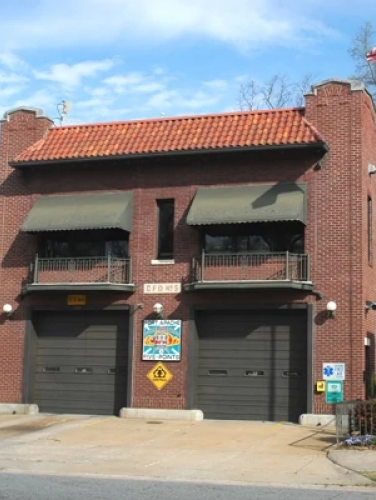
Charlotte Fire Station No. 5
(ca. 1929)
The Charles Christian Hook-designed Fire Station Number 5 is one of only three pre-World War II fire stations still in operation as firehouses in Charlotte.
224 Wesley Heights Way, Charlotte, NC 28208
Charlotte’s first firefighters were all volunteers, initially coming together as bucket brigades. Over time, those brigades evolved into firefighting companies, but remained purely voluntary organizations. By 1865, three volunteer companies served the city: the Hornet Steam Engine and Hose Company, the Independent Hook and Ladder Company, and (because like most organizations of that era, segregation also impacted firefighting companies) the all-Black Neptune Hand Engine Company. Like other growing industrial and commercial cities in the late nineteenth century, Charlotte experienced an increased concentration of structures, many soaring to unprecedented heights and constructed with highly combustible materials. Those conditions seriously jeopardized the viability of urban life, so Charlotte needed a more systematic and reliable means to fight fires and prevent widespread destruction.
Property Quick Links
Volunteer firefighters were not the ideal solution, as they were not held in high esteem in the nineteenth century. The public generally viewed them as a public menace, more like a rowdy fraternal organization than a public service. It was not until they became municipal employees, more focused on saving human lives than protecting property, that firefighters came to be viewed as heroic public stewards. In August 1887, after disagreements with Charlotte city officials over the volunteers’ misconduct prompted a mass walk-out by Charlotte volunteer firefighters, the city established the Charlotte Fire Department.
Many of the first municipal fire stations were grand brick structures lavishly decorated with stone carvings. More aesthetically pleasing firehouses appealed to the suburbanites whose neighborhoods hosted these stations. But it was also hoped that such commodious living quarters would help with the recruitment of moral and civic-minded men whose courage would underscore their image. Like many cities, Charlotte hired locally renowned architects to design municipal buildings as public art. Innovations in transportation technology also contributed to firehouse upgrades. In 1911, when Charlotte replaced its horse-drawn fire engines with motorized fire engines, the city’s fire stations no longer needed to double as horse stables and living quarters for firefighters. Firehouse designs could now focus on the health of the residents with innovations like cement (rather than wooden) floors, more windows for better ventilation, and full kitchens to support a two-platoon system of labor.
Charles Christian Hook (1870-1938) designed Station Number 5. A native of Wheeling, West Virginia, Hook originally moved to Charlotte in 1891 to teach mechanical drawing in the city’s public schools. However, his career plans quickly changed as he became Charlotte’s first full-time professional architect. Hook designed some 800 to 1,000 homes and buildings across the Carolinas, including two more Charlotte fire stations (Numbers 4 and 6, at 420 West 5th Street and 249 South Laurel Avenue), Charlotte’s City Hall and federal courthouse, the Carolina Theater, Duke Mansion, Myers Park Elementary School, and several buildings on numerous North Carolina college campuses (including the Chapel Hill and Greensboro campuses of the University of North Carolina, Davidson College, N.C. State University, Duke University, Queens University, East Carolina University, and Guilford College). Hook’s Fire Station Numbers 5 and 6 are two of only three pre-World War II fire stations still in operation in Charlotte as fire stations.

